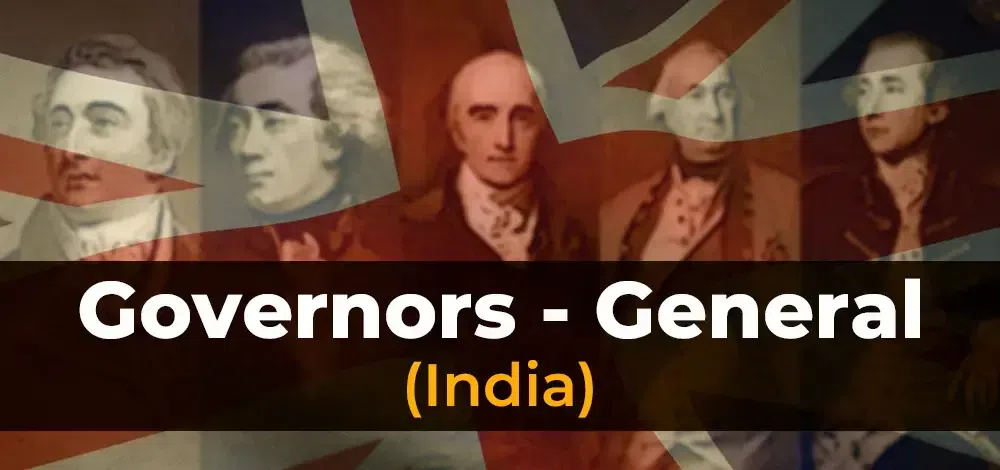
TOPIC 5.8 GOVERNOR-GENERALS OF BENGAL
1.Warren Hastings (1772-85)
He became Governor of Bengal in 1772 and first Governor-General of Bengal in 1774, through the Regulating Act of 1773.
He abolished the dual system of administration.
Divided Bengal into districts and appointed collectors and other revenue officials.
Established India’s first Supreme Court in Calcutta.
He founded Asiatic Society of Bengal with William Jones in 1784 and wrote the introduction to the first English translation of the Gita by Charles Wilkins.
Started Diwani and Faujdari adalats and the district level Sadar diwani and Nizamat adalat (appellate Courts).
He redefined Hindu and Muslim laws. A translation of code in Sanskrit appeared under the title Code of Gentoo laws.
First Anglo-Maratha War occurred during his period, which ended with the Treaty of Salbai (1776-82).
Second Anglo-Mysore War (1780-84), ended with the Treaty of Mangalore.
Rohilla War in 1774.
Pitt's India Act, 1784 and Edmund Burke Bill, 1783 was passed.
Deprived zamindar of their judicial powers. Maintenance of records was made compulsory.
Impeachment proceedings started against him in Britain on the charges of taking bribes. After a trial of 7 years, he was finally acquitted.
2.Lord Cornwallis (1786-1793)
First person to codify laws (1793). The code separated the revenue administration from the administration of justice.
He introduced the Izaredari System in 1773.
He started the Permanent Settlement of Bengal.
He created the post of District Judge. He is known as Father of Civil Services in India.
Third Anglo-Mysore War and the Treaty of Seringapatam.
He undertook police reforms.
Reform of the Judiciary (1793) setting up courts at different levels and separation of revenue administration from Judicial administration.
3.Lord Wellesley (1798-1803)
Introduced the system of Subsidiary Alliance. Madras presidency was formed during his tenure.
In the Fourth Anglo-Mysore War 1799. Tipu Sultan died.
First subsidiary treaty with Nizam of Hyderabad.
Second Anglo-Maratha War.
In 1800, he set-up Fort William College in Calcutta. He was famous as the Bengal Tiger. He brought the Censorship of Press Act, 1799.
Subsidiary Alliance
The subsidiary alliance system was used by Wellesley to bring Indian states within the orbit of British political power.
Under this system, the ruler of the allying Indian state was compelled to accept the Permanent Stationing of a British force within his territory and to pay a subsidy for its maintenance. The British promised that they would not interfere in the internal affairs but this was a promise they seldom kept.
It disarmed the Indian states and threw the British protectorate over them.
First to accept subsidiary alliance was Nizam of Hyderabad 1798, the second was the
Nawab of Awadh, 1801.The Peshwa, the Bhonsle, the Scindhia and Rajputs of Jodhpur, Jaipur accepted the subsidiary alliance.
4.Lord Hastings (1813-23)
Adopted the policy of intervention and war.
Anglo-Nepal War (1813-23).
Third Anglo-Maratha War (1817-18).
Introduced the Ryotwari settlement in Madras by Thomas Munro), the Governor.
Treaty of Sangli with Gorkha (1816).
Treaty of Poona (1817) with the Peshwa.
Suppression of Pindaris (1817-1818).
Governor Generals of India
1.Lord William Bentinck(1828-1835)
Most liberal and enlightened amongst all the Governor-Generals of India,
Regarded as the ‘Father of Western Education In India.
Abolition of Sati in 1829.
Suppression of Thuggee (1830).
Passed the Charter Act of 1833.
Deposition of Raja of Mysore annexation of his territories (1831).
Treaty of Friendship with Ranjit Singh (1831).
Annexed Coorg (1834) and Central Cachar(183l)
2.Lord Dalhousi (1848-56)
Second Anglo-Sikh War (1848-49) and annexation of Punjab.
Abolished titles and pensions.
Widow Remarriage Act (1856).
Introduced Doctrine of Lapse.
Woods Educational Despatch of 1854.
Introduction of the Railway, Telegraph and time Postal System in 1853.
Establishment of a separate Public Works Department in every province.
An Engineering College was established at Roorkee.
Planned to open universities in Calcutta, Bombay and Madras on the model of Universities of London.
Second Anglo-Burmese War (1852).
Santhal uprisings (1855-56).
Charter Act of 1853.
